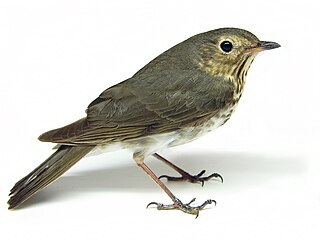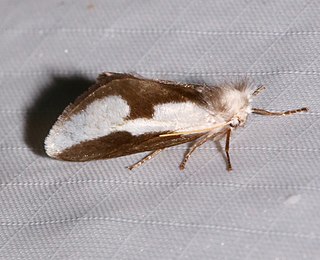
The veery is a small North American thrush species, a member of a group of closely related and similar species in the genus Catharus, also including the gray-cheeked thrush, Bicknell's thrush, Swainson's thrush, and hermit thrush. Alternate names for this species include Wilson's thrush and tawny thrush. Up to six subspecies exist, which are grouped into the eastern veery, the western veery or willow thrush, and the Newfoundland veery.

The hermit thrush is a medium-sized North American thrush.

Swainson's thrush, also called olive-backed thrush and russet-backed thrush is a medium-sized thrush. It is a member of genus Catharus and is typical of it in terms of its subdued coloration and beautiful, ascending flute-like voice. Swainson's thrush was named after William Swainson, an English ornithologist.

The gray-cheeked thrush is a medium-sized thrush. This species is 15–17 cm (5.9–6.7 in) in length, and has the white-dark-white underwing pattern characteristic of Catharus thrushes. It is a member of a close-knit group of migrant species together with the veery and Bicknell's thrush; it forms a cryptic species pair with the latter. The gray-cheeked thrush is all but indistinguishable from Bicknell's thrush except by its slightly larger size and different song. The two were formerly considered conspecific. Of all the American spotted thrushes, the gray-cheeked has the most northern breeding range.

Bicknell's thrush is a medium-sized thrush, at 17.5 cm (6.9 in) and 28 g (0.99 oz). One of North America's rarest and most localized songbirds, it breeds on coniferous mountain tops and disturbed habitats of northeastern North America. While very similar in appearance and vocalization to the gray-cheeked thrush, the two species, with two completely different breeding ranges, differ slightly in their morphology and vocalizations. It was named after Eugene Bicknell, an American amateur ornithologist, who made the first scientific discovery of the species on Slide Mountain in the Catskills in the late 19th century. John Burroughs, in his essay, "The Heart of the Southern Catskills" (1886), writes effusively about the voice of Bicknell's thrush heard near the summit on his climbs of Slide Mountain, and how on his stays on Slide saw them nowhere else but "about the summit", and saw no other thrush but Bicknell's.

Norape is a genus of moths in the family Megalopygidae. The genus was erected by Francis Walker in 1855.
Norape albilineata is a moth of the family Megalopygidae. It was described by Walter Hopp in 1927. It is found in Brazil.
Norape acuta is a moth of the family Megalopygidae. It was described by Walter Hopp in 1927. It is found in Costa Rica.
Norape draudti is a moth of the family Megalopygidae. It was described by Walter Hopp in 1927. It is found in Mexico.
Norape truncata is a moth of the family Megalopygidae. It was described by Walter Hopp in 1927. It is found in Venezuela, Peru and Colombia.
Norape variabilis is a moth of the family Megalopygidae. It was described by Walter Hopp in 1927. It is found in Brazil.
Norape zikaniana is a moth of the family Megalopygidae. It was described by Walter Hopp in 1927. It is found in Brazil.
Norape damana is a moth of the family Megalopygidae. It was described by Walter Hopp in 1930. It is found in Brazil.
Norape plumosa is a moth of the Megalopygidae family. It was described by Arthur Gardiner Butler in 1877. It is found in Costa Rica, Panama and the Amazon region.

Norape virgo is a moth of the Megalopygidae family. It was described by Arthur Gardiner Butler in 1877. It is found from southern Texas and southern Arizona to Colombia.
Norape argyrorrhoea is a moth of the Megalopygidae family. It was described by Jacob Hübner in 1825. It is found in Argentina, Trinidad, Brazil, Guyana, Venezuela, Paraguay, Panama, Costa Rica and Mexico.
Norape puella is a moth of the Megalopygidae family. It was described by Francis Walker in 1855.

Norape tener, the mesquite stinger moth, is a species of moth in the family Megalopygidae. It was described by Herbert Druce in 1897. It is found in Mexico and the south-western US.
Norape vesta is a moth of the Megalopygidae family. It was described by William Schaus in 1892.
Norape xantholopha is a moth of the Megalopygidae family. It was described by Harrison Gray Dyar Jr. in 1914. It is found in Panama, Guatemala, Colombia and Peru.







